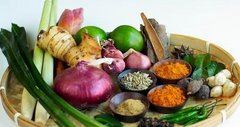Bāozio 包子 are a very popular Chinese breakfast item. These buns usually present themselves as sweet or savoury fillings wrapped in a dough and also it is one of the popular street foods in China or Southeast Asia.
Surprisingly, steam bao find its origin in the 2nd century, when this food was much simpler. Over the course of history, steamed baos have witnessed many changes, which leads to the diversity of this traditional Chinese delicacy. Today, you can find bao in different sizes, shapes and with various stuffing.
Today I decided to make a vegan vegetables bao using bangkuang (know in Malaysia) Bangkuang/ sa kot/ yam bean/ jicama is a tuberous root native to Mexico. The Spaniards spread its cultivation to Philippines, and from there it went to China and other parts of Southeast Asia. It is sweet with a crisp texture and yellow papery skin. It is commonly eaten raw in salads such as Rojak and Yee Sang. It is an essential ingredients in Jiu Hu Char or Popiah. That is how bangkuang look like as below photo.
For the bao dough follow the link below:
For the filling:
- 750g coarsely shredded bangkuang/jicama/yam bean
- 200g coarsely shredded carrot
- 5 dried shitake mushroom, soaked to softened and cut into small pieces
- 2 pips garlic, finely chopped
- 3 stalks of fresh coriander, finely chopped
- 2 tbsp sesame oil
- 3-4 tbsp vegetarian oyster sauce
- 2 tbsp light soy sauce
- 1 tbsp sugar
- 1 tsp white pepper
- 2 tbsp cooking oil
- salt to taste
Method:
For the filling: Heat 2 tbsp cooking oil, add in the garlic and fry until fragrant, then add in the carrots. Stir for 1-2 minutes. Add in the bangkuang and continue frying for another 2 minutes.
Add in the oyster sauce, light soy sauce, sesame oil and salt. Mix well and add in about ¼ cup water and bring to boil. Once boil, let it simmer until soft and nearly dry. Just before taking the fillings off the heat, add additional seasoning such as white pepper, salt and sugar. Make sure you are slightly heavy handed adding in the seasonings because it will be eaten with steamed buns which is plain.
Transfer the cooked fillings to a bowl. Leave it aside to cool completely before filling the bun.
To fill the bun, shape the dough into round shape using a rolling pin. Put the dough on your hand or on top of the table. On the top of the dough, put 1-2 tbsp of the cooked fillings. Pull up the sides of dough and seal off the edges with your fingers. Well seal needed so that the fillings do not burst out from the dough.
Put the buns on top of a square baking paper on top of the steamer rack. Leave space of about 1.5cm between the dough for expansion. Proof the dough for another 30 minutes or almost double in size. By the end of the second proofing, you will notice that the dough skin become smoother as compared to before proofing.
After the second proofing, get ready the steamer with some water. Bring to boil. When the water boils, steamed the buns under high heat for about 15 minutes. After 15 minutes, off the heat and let the buns sit in the steamer, without opening the lids for about 10 minutes before transfer the buns out of the steamer. The process of letting the buns sitting in the steamer is to prevent wrinkles and rough surface appearing in the buns. Put the buns in cooling rack.
Best served warm as breakfast or snack items. Re-steam the buns for 3-4 minutes will make the buns soft as if they are freshly prepared.









No comments:
Post a Comment